It will not knock the wind out of us all at once — it will surge, subside, return, and then return again, until we learn that we must learn to live with it. In between a roar and a trickle, littered with the bits and pieces of city life that it so inadvertently disrupts, the ocean will rise. Salty, murky, and unforgiving, it will lap at the base of the Ivory Tower. And it will stay.
The primest of Harvard’s real estate will be the first to go. A crop of giddy freshmen will score Winthrop House on Housing Day, not knowing they will be the first who have to wade back home. Relentless, the water will wash through Eliot and Kirkland, Quincy, Lowell, Leverett, Dunster, and Mather. The Lampoon castle will become moated by Mount Auburn Street.
Some students will be sleeping, and will not hear the thunder, or the rain, or the very first sounds of the sea. They will be woken by the din of waves and mayhem, as the Atlantic makes its chaotic Cambridge foray. Across what was once a river, the Business School will be almost completely underwater, as will much of Boston. Cold and clean from the sky, brown and brackish from the sea, water will merge and surge and render Adams House oceanfront.
The skies will clear. Shortly thereafter, so will the water. It will leave a mess behind. And it will come again. Too soon, it will not take a storm for the sea to swell. The moon will be full and high tides will be higher, and there will be a sunny day when the tide quietly draws the ocean back up just as far. About twice a month, by the end of this century, Harvard will get soggy, and emergency will become normalcy.
Rising sea levels and the havoc they will wreak are dystopian, but they are not hypothetical. Algorithms, not imagination, are the backbone of these projections — they come straight from an extensive report on rising seas published in 2017.
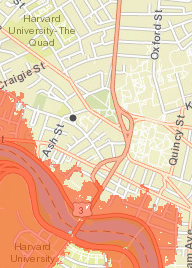
But if this fate is so devastating, so imminent, and so certain, why is it so undiscussed? The eery irony is that Harvard students aware of the campus’ vulnerability to rising seas are about as few and far between as those who deny that the climate is changing.
Meanwhile, under most radars, a slew of administrators, scientists, elected officials, journalists, artists, and engineers are taking this threat seriously, joining forces, and hitting varying degrees of freaked-out. Even though the public may not seem to be watching, the science is too glaring and the impending costs too tremendous for the powers that be to ignore. While these projections may not hit for another 50 years, most of Harvard’s residential houses have been around for almost 90, so current renovation plans, like that of Lowell House, absolutely must keep rising seas in mind.
This is not to say they have it under control. It turns out that exactly what it means to “keep” this inevitable catastrophe “in mind” is controversial, unclear, and thus conducive to vague expressions. So while there is some incentive to plan ahead, it cannot be done without first deciding what that should look like. Taking a look at all the ways that such a proactive and well-resourced place like Harvard nevertheless finds itself perplexed and paralyzed reveals what is truly confounding when it comes to preparing for rising seas.
Sea level rise is not just a Future Us problem. While college students tend to put most things in that category, the consequences of inaction are substantially more ominous with respect to rising seas than dirty laundry. The choices that leaders make today will either save or screw us over down the road. Especially for those of us hoping to be around for several more decades, it’s time we pay attention.
Prophecy and Policy
It turns out that predicting and then planning for such a far-out future is not only tricky — it has literally never been done before. Prophecy has traditionally been left to fortune-tellers, fiction writers, and the entertainment industry. We have an entire genre of dystopian fiction, from 1984 to The Martian, that we get a thought-provoking kick out of but would never make the basis of real policy. The climate scientists working on this question are in uncharted territory.
Erika Spanger-Siegfried is one of them. Her office is right in Harvard Square, and she works at a think tank founded by some MIT scientists in 1969. She grew up in Salem, Mass., with the ocean down the block. When there is a full moon, and the high tides get higher, the waves often creep all the way up onto the busy road behind her parents’ house. This did not used to happen.
So for Spanger-Siegfried, this issue is both present-tense and personal. What she is working to make clear is that too soon, it will be for everyone. “This is going to start feeling like a national problem in the next couple of decades,” she stressed in an interview with HPR. It is her projections that the previous descriptions of Harvard are based on.
To help get this through people’s heads, she created this map, which predicts when different places will start seeing regular flooding by all the highest high tides. If you are curious, and live near the coast, brace yourself and plug in your own zip code.
But Spanger-Siegfried’s projections are not the only ones out there. There are many others, and they vary widely in terms of exactly what they predict. Harvard’s fate is dire but not at all definitive. This is because there are four big questions to consider, and different answers to each cause projections to drift farther and farther apart.
First, is the global community going to cut carbon emissions? That depends on all kinds of things, including who wins the next election, and whether the United States re-enters the Paris Agreement. Then, how quickly are the carbon emissions going to cause ice melt? There are scientists down in Antarctica keeping tabs on that, and they have recently been finding that it is a whole lot faster than initially expected. Third, throw in all the uncertainty about when and where big storms are going to hit. Before the seas are so high that the tides are actually flooding into Cambridge, Harvard will get flooded during a big storm that whips the tide up a few extra feet. We know that these storms are going to be getting more frequent, but the question of when a big one comes along, strikes Boston during its high tide, and floods all the way to Harvard, is hard to guess. Finally, none of the predictions can take into account the engineering moves that Boston or other cities might make to hold back some of the flooding.
The upshot is that there are a bunch of different projections for just how soon sea level rise flooding at Harvard is going to be a problem. Click through the ones produced by the city of Cambridge, the city of Boston, the state of Massachusetts, Boston Harbor Now, and NOAA if you are curious. The scenario I described earlier is thus neither representative of nor at odds with the scientific consensus, because there isn’t one.
Unlike every other political debate, it is not divided into partisan camps, and no one claims to have the definitive right answer. Some projections are more conservative, others are more extreme, but according to Carl Spector, the city of Boston’s environmental commissioner, the disagreement about the rate of sea level rise is all about that series of uncertainties. “It’s not because the underlying science is different, it’s because you’ve made a series of choices,” Spector explained in an interview with the HPR. By the time you’ve “chosen” a rate of carbon emissions from the range of possibilities, and then a rate of ice melt, and then a frequency of storms, you have a totally different prediction than someone else looking at the same data.
Are these choices arbitrary? Sort of. But they are also subjective, which means that the biases and interests of non-scientists gets mixed in with the data. Spector explained that “different people and institutions will have different amounts of risk tolerance, and they have to make a decision about what is a reasonable amount to plan for.” It matters quite a bit what we end up deeming a “reasonable amount.” Given that there is so much discretion involved, and that no one is paying particularly close attention, it is important to take a closer look at who’s defining “reasonable,” and why.
After clicking through the tools, it starts to seem that the city of Cambridge is going with numbers that seem unreasonably low. According to their tool, it probably will not be until next century that Harvard’s undergraduate campus sees the kind of chronic flooding that Spanger-Siegfried’s tool projects for 2080.
Inside Cambridge City Hall
John Bolduc is Cambridge’s environmental planner. He is the city’s go-to guy when it comes to preparing for rising sea levels, and he is convinced that all things considered, the city is pretty on top of it. In response to Spanger-Siegfried’s projections, he told the HPR, “That’s not happening this century.”
The projections Cambridge is using expect storm surge flooding around the time Spanger-Siegfried predicts tidal flooding. But even Cambridge’s projections, Bolduc thinks, are a bit much.
“I think the sea level projections that we’re using are a little pessimistic, I hope.” We laughed at the irony of his optimism about the pessimism. “For 2070, we’re assuming 3.3 feet of sea level rise, which is aggressive I think.” The graph Cambridge uses is below.

But that is the same number Spanger-Siegfried is using, which is confusing, but just speaks to the unique nature of this issue. The differences between Bolduc’s and Spanger-Siegfried’s projections are probably more technical than political. Even though they have judgment calls built in, they differ more due to the fundamental uncertainty of the rate and scale of the problem, than their attitudes.
“All models are wrong,” Bolduc says. “There is no right model. No one has a perfect crystal ball. All you can do is use the best model you have available to you.”
Not only that, but the rate of rise is really not all that important. Even if it is slower than predicted, it is only a matter of time. “It’s important to recognize that [global mean sea level] rise will not stop at 2100; rather, it will continue to rise for centuries afterwards,” according to the same NOAA report.
And so the real debate is not over the projections themselves — it is about what should be done about them. It is not happening between Bolduc and scientists like Spanger-Siegfried, but rather within City Hall itself.
City Councilor Quinton Zondervan grew up in Suriname, and his grandparents’ house was built up on stilts so that when big storms came through and flooded the area, life could continue uninterrupted. Flooding did not spell soggy, costly doom for most of the community — people had simply adapted to it. As a kid, Zondervan had no idea how many others would soon have to do the same.
When he found out that the seas were rising — quickly — he was dumbfounded. “I didn’t know this was problem until college, when somebody told me, and I said ‘Why aren’t we doing everything to stop this?’” Zondervan told the HPR.
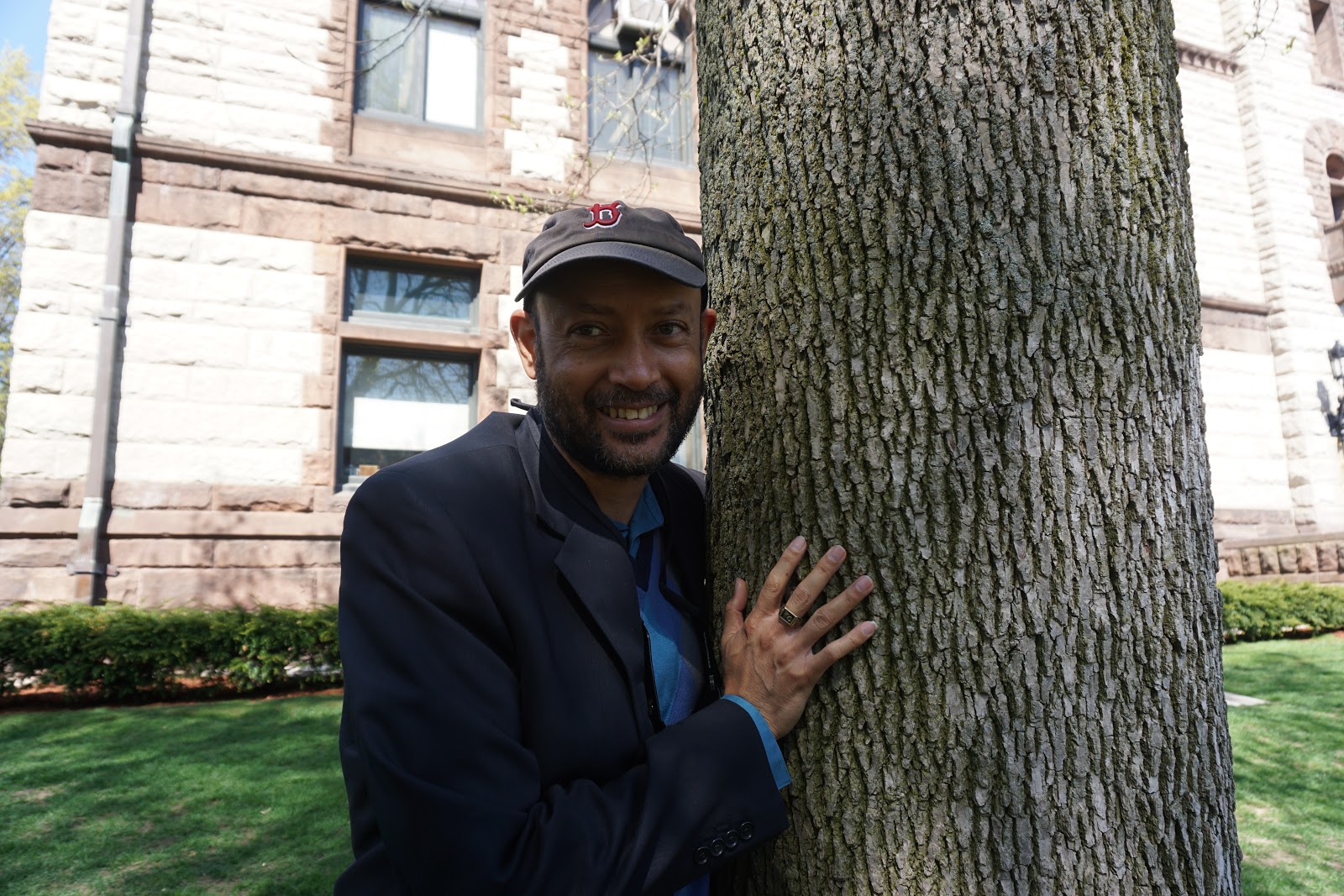
He came to Cambridge to study at MIT. Here, it’s harder to picture the stilts solution working quite as well. Pretty soon, Zondervan was chairing Cambridge’s Climate Protection Action Committee, and pushing the city government to get a little more concerned about just how soon this kind of flooding is going to become a problem. Like Spanger-Siegfried, he understands firsthand how real it is. “This is not some weird future thing,” he emphasized. “This is happening now.”
In 2011, the city responded by doing a vulnerability assessment, and then updated it in 2015. Bolduc was in charge. The results were startling. For Harvard’s part of Cambridge, it all revolves around just how long the Charles River Dam will be able to hold the ocean back.
“For now, we’re okay. But in the next couple of decades, that’s going to start to change as the sea levels continue to rise and the intensity of the storms continue to increase. At some point mid-century, we’re going to be concerned that we have a storm surge type event that does overflow the dams.” Zondervan speaks slowly and deliberately, with a grave tone that reveals just how much this future weighs on him. He doesn’t seem flustered or alarmed — more haunted.
Last fall, he became a Cambridge City Councilor. When we met, he was wearing a baseball cap and a blazer, with two pins on his lapels. One said “GreenCambridge,” and one had the words “Climate Change” in the middle of a bright red stop sign. He does not think the city is doing nearly enough.
Other cities are in denial about climate change altogether. But Zondervan worries that “in Cambridge and Boston in general we suffer from an almost more dangerous kind of denial. We say, ‘Yeah of course it’s happening, we get it, here’s all the 50 million things we’re doing about it, so we’re good.’ But it’s like, no, it’s not enough. It comes up all the time in decisions that we have to make.”
Bolduc doesn’t share Zondervan’s sense of frustration and urgency. He defends the city’s attentiveness to the issue — which is understandable, given that he is directly in charge of it. But his defense sounds a bit like the sort of narrative Zondervan is critiquing. “Compared to other cities, I think we’re on the leading edge,” he confidently affirmed.
He is worried about the opposite problem: he does not want alarmism to steer the city toward wasteful mistakes. “The hard part with the uncertainty is that there are costs if you over-invest in something because you’re overly pessimistic,” he explained. He is skeptical about taking action given how little we know about what this flooding is going to look like. The idea that any action is better than no action is not quite right, without knowing if those efforts will be useful down the road.
Bolduc grasps the grander scale of just how novel and confounding this challenge is. “It used to be that cities would plan by looking at what happened in the past. But we can no longer look to the past to tell us what the future is gonna look like. The future is going to be a constantly shifting situation.”
Zondervan and Bolduc are both right, and they diverge only because they are dealing with the novel paradox of prophecy and policy. The thing with predicting the future is that it can change the future; what we do in the present depends on what we predict, but can also transform it.
Reduce, Reuse, Recycle?
So it’s bad. Is there anything we can do about it? The sea is going to rise, but how fast and how high is critically tied to whether we can get our act together and cut back carbon emissions. As Zondervan talked about the various “solutions,” he stopped and emphasized that there is really only one. “We have to start thinking really big — the right answer is to keep that water from rising.”
Whether or not the United States reenters the Paris Agreement will be a big deal. Zondervan was in Paris for the negotiations. The goal there was preventing a two-degree increase in global temperature, but Zondervan remembers hearing from the Marshall Islands, whose slogan throughout the talks was “1.5 to stay alive.” For this small island nation in the South Pacific, sea level rise is an existential threat; at two degrees, the entire nation will literally be underwater. Even with the Paris standards, we should expect some Atlantises. So while Zondervan has been busy pushing Cambridge to build responsibly, the reality that his city is far better off than many, and that the focus should be on mitigating rather than preparing for this global catastrophe, is never far from his mind.
According to Spanger-Siegfried, however, Harvard could be in a position where the Paris standards are actually make-or-break. As she predicted, “Cambridge is one of the communities that could be spared from chronic inundation by adhering to the goals of the Paris agreement.” Unlike the Marshall Islands, Cambridge is lucky enough that its fate is still a little up in the air.
But the truth is that even here, it is far too late to reduce-reuse-recycle our way out of this. This past January and March, the city of Boston saw record flooding during two monstrous storms. The governor declared a state of emergency the second time, and the National Guard came out to help rescue victims. Those two recent storms are both in Boston’s top three storm surges ever recorded. Boston’s Seaport and Long Wharf districts — as well as towns up and down the shore — got a taste of the dystopia that for Harvard is still a few decades away.
And so even as officials and administrators strive to limit carbon emissions, there is no denying that it is time to start preparing for the worst. At some point, despite all the uncertainty, they will have to pick a spot on the moving target of projections and aim for it, if they are going to do any kind of planning ahead.
“It was fabulous that Harvard announced that they’re going to be fossil free by 2050. But that’s not enough. Even if we do that, we will not have averted the danger of flooding out the entire campus in 100 years,” Zondervan stressed.
Adaptation at Harvard
When asked how policymakers and administrators should be preparing for sea level rise, Spanger-Siegfried said, “It depends. Are we building a sand castle or a military base?”
Lots of money is going into the new river houses like Winthrop and Lowell, as well as the new Allston campus for the School of Engineering and Applied Sciences. It would be costly and humiliating if a few decades down the road they were underwater. Spanger-Siegfried’s point is that the amount of sea level rise to plan for depends case-by-case on the stakes of the project. Is it meant to last 10 years, or 100? In a place like Cambridge, it is mostly those long-term investments that have got to start being pretty cautious.
With plans literally entitled “Creating a campus for Harvard’s next century,” Harvard is in that kind of a position. The timeline for the new construction shows a pretty picture that is cringeworthy juxtaposed to the various maps, and the flooding they forecast.
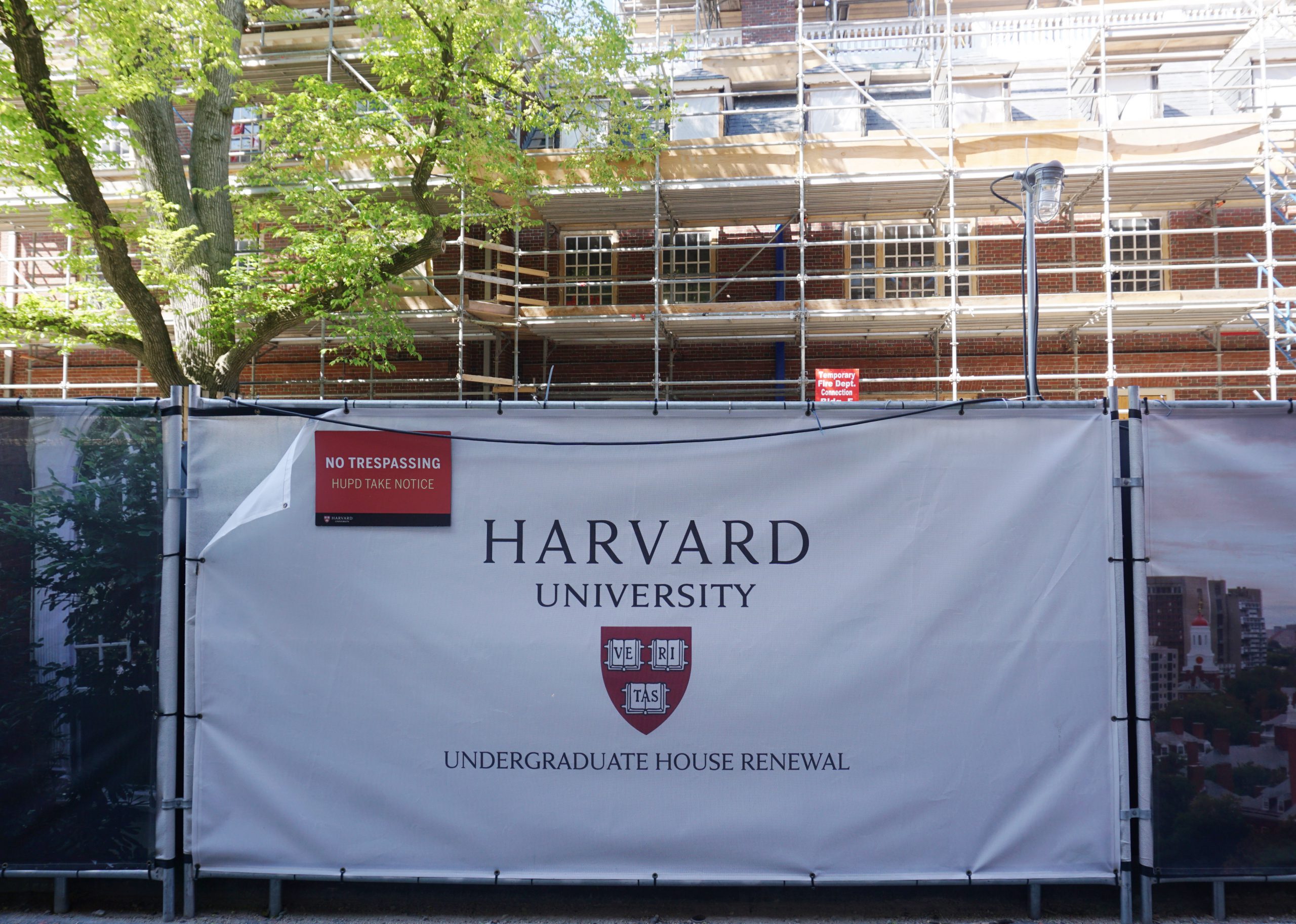
The flooding is predicted to be much more invasive, much sooner, on the Allston side of the river. Like many parts of Boston, Allston was originally wetland, until the Charles River dam enabled it to be developed. Now, it is at risk of reverting to its soggy origins.
But if any building project is going to be doing all the right things to be conscious of climate change, it should be the Harvard School of Engineering and Applied Sciences in Allston. It is certainly trying. The School’s Master Plan acknowledges that, “If the dam was overtopped or not effective, there is a possibility of flooding in the Allston campus.” Administrators have tried to plan accordingly; for example, plans to build an energy facility underground were nixed after the steering committee took a closer look at the projections. It is currently under construction, in a big building raised up high enough that flooding will not be an issue.
The same kinds of steps are being taken in the construction of the new river houses on the undergraduate campus. According to a Harvard spokesman, “A climate change impact study was completed prior to proceeding with the renewals. Recommendations incorporated into the Houses include locating critical infrastructure, such as emergency electric generators, above grade. Each House is also equipped with an under-slab drainage and pumping system for local flooding.”
But even though engineers have come up with various flood-proofing solutions, and Harvard is implementing them responsibly for now, most are designed to handle a more immediate and less intense kind of flooding — from heavy rain during the storms that are going to be bigger and more frequent — not from ocean water finding its way to Cambridge. Sea level rise flooding is on a whole other scale. Harvard’s construction projects have some great sustainability measures; “most defensive measures that we have in play today, though, are not built to keep out the tides,” explained Spanger-Siegfried.
Building the Allston Campus, or anything, under the assumption that seas are soon going to inundate it is simply not possible. How many Harvard engineers does it take to design infrastructure that can withstand the Atlantic Ocean barrelling into Cambridge at high tide during a Nor’easter? Trick question.
Instead, they are hoping to find a way to hold those waters back — and they are not alone. If the Charles River Dam were topped, it would be a catastrophe for the entire region. There is no doubt that both Harvard and MIT, whose campus is also at stake here, are going to channel the brainpower of their brightest engineers into adapting that dam so that it lasts. And they will be joined by the city of Boston and the state of Massachusetts in looking for creative solutions that deal with sea level rise flooding not on an infrastructural level, but a much bigger one.
“No city is capable of mustering the kinds of resources that are required to elevate the homes or build the defenses or continue to function effectively. They can turn to the states, but if states have lots of communities in the same boat, they’re going to need to turn to the federal government. So it becomes a national problem inevitably,” said Spanger-Siegfried.
Even with its considerable resources, there is only so much that Harvard can do. Eventually, it has to bank on the region coming together to pull off some kind of engineering solution that keeps the rising seas at bay. Perhaps even geoengineering could play a role.
That might be fair. It could just as easily be foolish. It is the perennial challenge of planning for an inherently uncertain future.
Liberals Building Walls
Thanks to our president, much of the country is convinced that building walls is a silly, expensive, and over-simplified solution to a complex problem. When it comes to immigration, this view is pretty fair. The Harbor Barrier Project has very little in common with Trump’s border wall. But it has gotten very similar critiques.
University of Massachusetts at Boston is busy researching the feasibility of building a wall around Boston Harbor. It might seem crazy. But the cost of the project could end up being less than all it would take to make buildings flood-proof, repair buildings that are not, and bail on all the property that is rendered uninhabitable as the seas rise. Another UMASS team has been working to do the math. No matter what, it is on the order of billions of dollars.
If the wall were built, all this alarm about the campus flooding would be obsolete. That sort of possibility adds a whole other layer to the uncertainty that makes Bolduc and others hesitate to take decisive action right now on the local level.
Zondervan, however, has qualms about putting too much stock in a sea wall to fix everything.
“How high do you build it? And where does the sea wall end? Because that’s where the water’s gonna go. It really becomes an exercise in futility. There’s a massive climate injustice component because even if you conclude that Boston is going to build a wall around our city, what about everyone else in the world?”
The towns north and south of the wall will be the most obvious victims of the injustice Zondervan is talking about. But more broadly, he is concerned that rising seas will prey upon the weak. Communities without the resources to adapt will quite literally be washed away.
Jesse Keenan over at the Graduate School of Design is an expert who has put a lot of thought into this dilemma. When Keenan was an undergrad, he was a singing, songwriting rock musician. Now, he wears bow-ties and can articulate the nuanced pros and cons of climate change adaptation and resilience. He is similarly skeptical.
“Let’s say we figure out how to manage the Charles River watershed. What does that mean for Lynn, for Saugus, for Revere, for the north shore and the south shore? You can’t just build a sea wall around Boston. It’s not so easy.”
In an interview with the HPR, he was quick to point out that smaller-scale adaptations are not necessarily worth it either. “We assume that Harvard trying to be resilient is the right thing to do and it’s not so easy, because there are trade-offs along the way,” he warned.
His point is that as the seas rise and flood our cities and our campus, all kinds of money will go into repairing and rebuilding. There will be lots of quick fixes so that the evacuated can move back in. There will be also be proactive investment in making buildings better-able to withstand floods. But at some point, it will be smarter to just cut our losses.
“Resilience is an inherently conservative concept,” Keenan explained. “What should we be preserving? If we try to preserve something that’s wholly unsustainable, then that’s maladaptive.”
This is not just a strategic question — it is an ethical one.
“Today, our responsibility has been framed entirely in turning off the lights. It’s been entirely about climate mitigation. But we have an equal moral responsibility to understand what we should conserve and preserve and what amongst ourselves should we fundamentally transform.”
Fight or Flight
In many places, that “transformation” is going to mean simply giving up and moving out. It is a last resort that Harvard is going to do all it can to avoid.
But Zondervan does not consider it off the table: “We are talking about this more existential question of can the Harvard campus even be located where it is 100 years from now?”
The Water Will Come: Rising Seas, Sinking Cities, and the Remaking of the Civilized World is the eye-catching title of a book Jeff Goodell published last year that has garnered this issue some real attention. In an interview with HPR, he put it all pretty simply: “The solution to sea level rise is not going to be that complicated. People are just eventually going to retreat to higher ground. That’s already starting to happen.”
In the meantime, “there’s going to be tons of money wasted on various adaptation schemes.” But like in any crisis, you cannot save everything and everyone. You cannot grab all your nostalgic memorabilia and valuables when you run out of the house in a fire, and when the paramedics arrive at a car crash, they have to choose which victims to help first.
“In the big picture there’s going to be a kind of triage that needs to happen,” Goodell warned. We are going to have to decide what — and who — is worth saving.
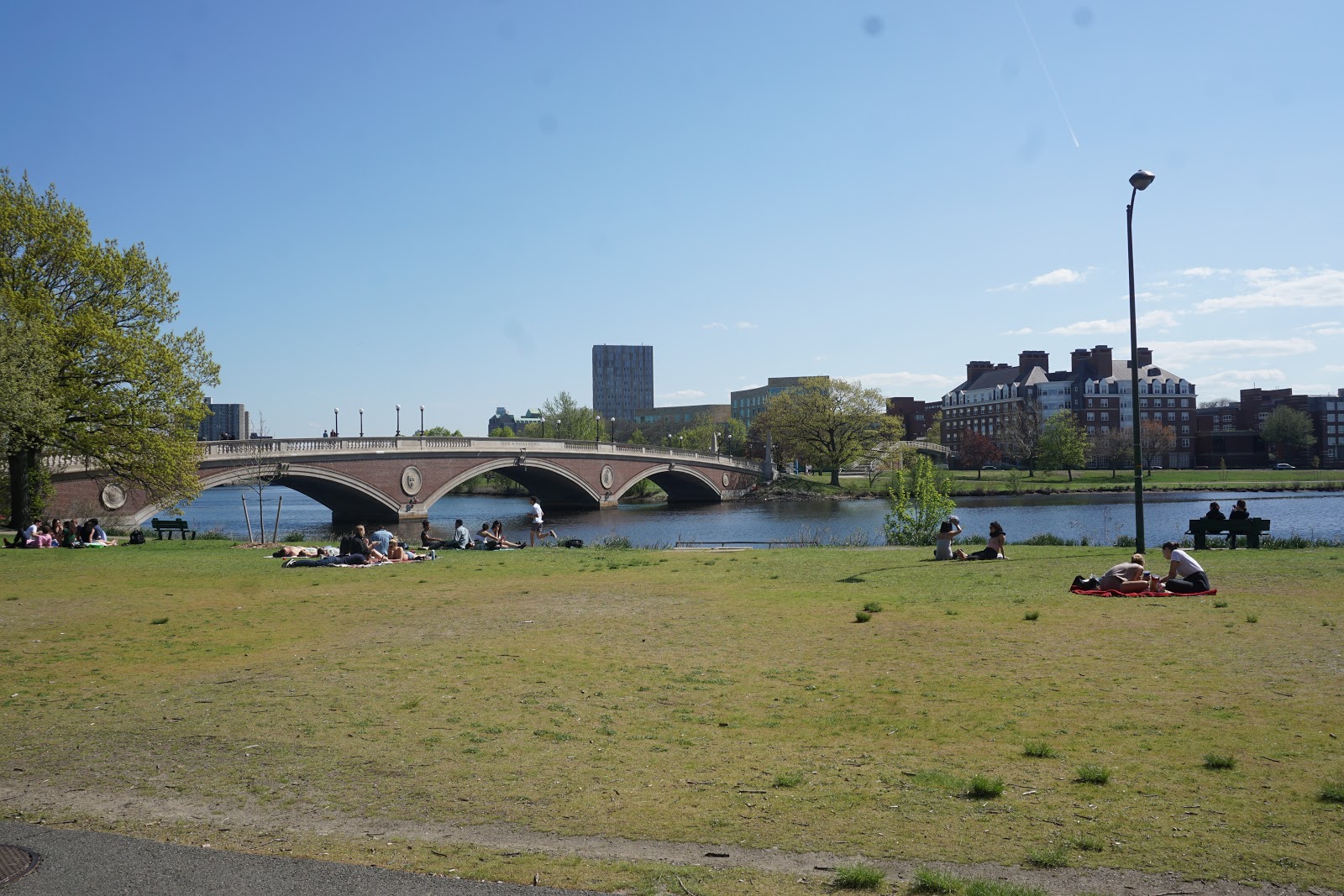
Best Case Scenario
So let’s say there ends up being some sort of solution to prevent chronic flooding on Harvard’s campus. We don’t retreat. We build the dam way up, or the sea wall, and we stick around. Even still, we will feel the impacts of the rising seas indirectly. “This is a totalizing impact,” Keenan emphasized. “And to think that somehow Harvard is separate and apart from this, that we can be insulated from this through our resources, would be incorrect.”
Maybe it will be the red line flooding, living standards in and around Cambridge decreasing, and good housing getting more expensive. Keenan worries that it will get harder for Harvard to compete for the top faculty and students. Even if the river is not flooded with seawater, at best it “might turn into more of a culvert,” or be contaminated from water coming from the other direction, according to Keenan. “Historically, the river has been an important part of Harvard. It’s what little public space we have. Will we still have that relationship with it? It likely will change.”
And by the time Harvard is faced with all this, not only will Boston already be dealing with much worse, but Cambridge will be getting hit by extreme heat waves and flooding from heavy rains, according to Bolduc. Rising seas are not the first effects of climate change that Harvard needs to prepare for.
From the North Shore to the Marshall Islands, there will also be communities that not only get hit way sooner, but lack the resources to adapt. It will be a global phenomenon before it is a Harvard one. Harvard will not make it out unscathed, but it will fare better than most. Others will not have the money for walls or stilts or fancy engineering solutions — they will lack the money to repair, let alone prepare.
If You’ve Read this Far
Then you are someone who is tuning into this impending challenge, and you might be perplexed that it is so chronically difficult to get others to do the same. As time goes on, coastal flooding will become increasingly impossible to ignore, as communities around the world literally submerge. But for the time being, calling most people’s attention to it will require some creativity.
Last November, you could have gone to a gallery at Harvard’s Graduate School of Design and sat down in a beach chair. Designer Joanne Cheung would have handed you a pina colada, and a pair of Virtual Reality goggles at what she called the “Harvard Beach Party.”
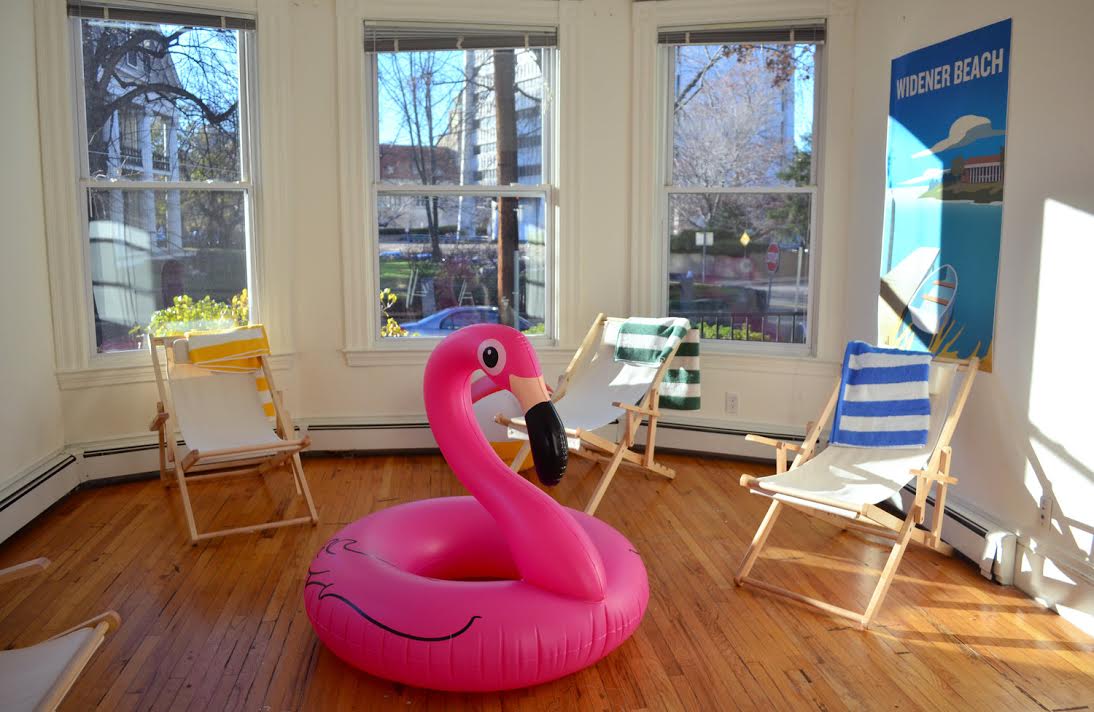
At the exhibit, you put on the goggles, and you see the same gallery you were just in, with the same four posters on the walls, but now you can pick one and dive inside. Let’s say you pick Widener Beach. In a split second, your stomach drops as you find yourself standing on a narrow wooden footbridge that leads from Memorial Church to Widener, and all around as far as you can see is several feet of water. There is a wooden boat to your right.
When you head to Sanders, you are on a little island with sandcastles and crabs at your feet. You can look around, 360 degrees, up and down, and it feels just real enough to shake you up but just surreal enough to be wacky and entertaining.
Cheung is behind all this. She had the help of peers Yaqing Cai, Yujie Hong, Cindy Hu, Namju Lee, Jiabao Li, Jenny Shen, Jiho Song, and Kally Wu. She has thought a lot about how to get a reluctant audience engage with the reality of rising seas.
“I wanted to avoid an apocalyptic narrative especially because there’s so many Hollywood movies with that narrative,” Cheung explained in an interview with HPR. “It was very playful. We wanted to think beyond the immediacy of the disaster, until when the disaster has been normalized. It was meant to seem weirdly familiar, but also a little bit alienating.”
Right now, the discussion of rising seas is primarily happening between scientists and bureaucrats, along with some developers and insurance agents. But Cheung feels strongly that “It’s a conversation that everybody should be having. We have a lot of data, there’s tons of science, but facts are hard to see. They’re abstract. We need things to help people relate back to their everyday lives. Artists can play a role.” When I asked which data she used as the basis for her research, she cited yet another online tool.
We need technical experts to get into the nitty gritty. But Cheung understands that if that keeps dominating the discourse, everyone else will keep zoning out.
“The idea was, ‘Here’s a very serious topic, but we’re all drinking pina coladas.’ It’s an issue that’s serious but simultaneously very mundane — so mundane that people forget about it. You need to add a little theatricality to get people excited.”

Some experts, like those in Cambridge, will keep talking amongst themselves in technical gibberish and come up with projections and regulations and resilient infrastructure. That’s great, and we need much, much more of it — in Cambridge, Boston, and especially elsewhere where this discussion has yet to even begin.
Without popular oversight, however, that will never be enough. Responses to climate change are not straightforward given the technical know-how — they involve profound ethical judgment calls. If we let those calls get made without our oversight — or purely on the basis of cost-benefit analysis — we could end up living in a world in which seawalls protect and define the next generation of “gated communities,” as their neighbors get washed away. Those on the younger side must also keep our eyes peeled to make sure that today’s leaders are nоt privileging quick fixes that use our tax dollars to cover their asses in the short term, only to leave us with expensive, “resilient,” and utterly useless infrastructure down the road.
Any beachgoer knows that feeling of flustered alarm when a particularly big wave sends a shallow splash creeping all the way up the sand and onto their towel. Sometimes it even snatches a flip flop, sending an indignant victim running after it. We know that tides rise, and sometimes we even have an inkling that it is on its way up. Yet we remain on our towels in lazy, sun-soaked denial. We are disgruntled upon being overtaken, even though quickly and preemptively dragging our towels a few feet up the sand would have done the trick.
After January’s storm hurled icy seawater through the streets of Boston, Mayor Marty Walsh told CBS News that, “When the high tide came in, it caught a lot of neighborhoods by surprise.” The present and impending threat of rising seas is formidable because of both its scale and inevitability — but it is up to us to cling to the one edge we have and deny it the element of surprise. Foresight may not be 20/20, but it can be the difference between thoughtful triage and precaution, and frantic floundering. We’re saving campuses and countries — not flip flops. Let us not bask in complacency or confusion when there is so very much at stake.
The cover art for this article was created by Marie Konopacki, a student at Harvard College, for the exclusive use of the HPR’s Red Line.
Image Credits: Union of Concerned Scientists (Image 1), NOAA (Image 2), Eve Driver/Harvard College (Images 3-5), and Joanne Chung/Harvard GSD (Images 6-7).
